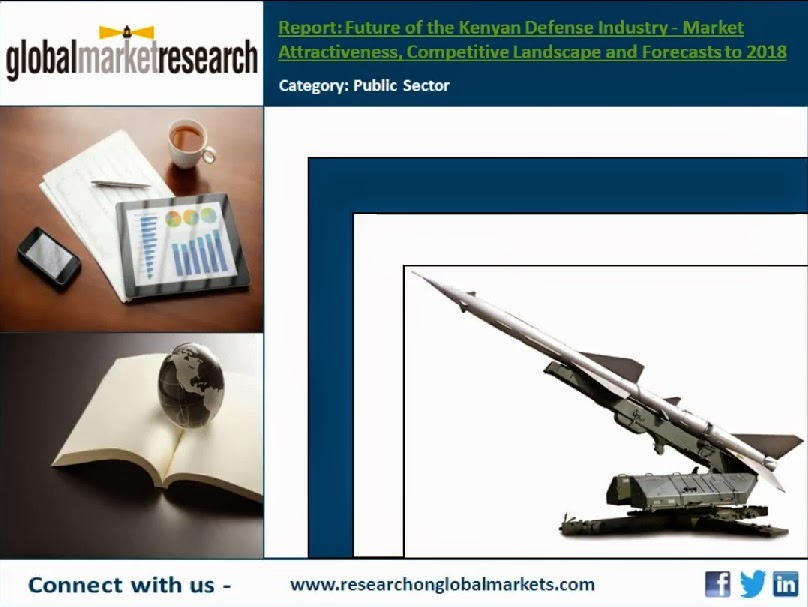This report is the result of SDI's extensive market and company research covering the Kenyan defense industry, and provides detailed analysis of both historic and forecast defense industry values including key growth stimulators, analysis of the leading companies in the industry, and key news.
Key Features and Benefits
* The report provides detailed analysis of the current industry size and growth expectations from 2014to 2018, including highlights of key growth stimulators, and also benchmarks the industry against key global markets and provides a detailed understanding of emerging opportunities in specific areas.
* The report includes trend analysis of imports and exports, together with their implications and impact on the Kenyan defense industry.
* The report covers five forces analysis to identify various power centers in the industry and how these are expected to develop in the future.
* The report allows readers to identify possible ways to enter the market, together with detailed descriptions of how existing companies have entered the market, including key contracts, alliances, and strategic initiatives.
* The report helps the reader to understand the competitive landscape of the defense industry in Kenya. It provides an overview of key defense companies, both domestic and foreign, together with insights such as key alliances, strategic initiatives, and a brief financial analysis.
Key Market Issues
Kenya stands as one of the countries that encounter high levels of corruption in virtually all sectors of business activity. According to Transparency International's Corruption Perceptions Index 2013, Kenya is classified as a highly corrupt country. Corruption within the country has engraved itself in various forms ranging from bureaucratic and political affairs and misappropriation of public resources to fraud transactions related to state assets. To tackle the situation, the government formed the Kenya Anti-Corruption Commission (KACC), which was disbanded and replaced by the Ethics and Anti-Corruption Commission in 2011.
During the forecast period, Kenya is expected to invest US$5.5 billion in its armed forces, of which US$0.9 billion is forecast to be on the acquisition of military hardware, offering foreign OEMs limited opportunities to cater to the Kenyan defense industry. Although the allocation is higher than that of the review period, when it was US$0.6 billion, the budget still remains highly inadequate for the procurement of high-tech defense equipment. Furthermore, the country is expected to focus more on developing its economic conditions and bring in more wealth and prosperity for its people in the coming years. These factors do not make the Kenyan defense market an attractive investment destination for foreign companies.
Key Highlights
Kenya has been involved in a border dispute with Somalia over the last couple of years with Somali militant groups operating in Kenya's remote and barren North Eastern Province. Counties in the Kenyan region such as Wajir, Isiolo, and Mandera remain exposed to chronic instability making it difficult for local communities to lead a peaceful life. In 2010, extremist group Al-Shabaab attacked a Kenyan border patrol in Liboi,Lagdera. To combat such violent outbreaks, the Kenyan Defence Forceswaged a military operation against Al-Shabaab in southern Somalia and took control of certain Somali regions as well as some Kenyan territories including Ijara, Garissa, and Liboi. Tensions between the two neighboring nations heightened in 2012 following the discovery of offshore oil and gas deposits in East Africa, with both countries claiming to have ownership over the water zone. Furthermore, Kenya shares a long-standing strained relationship with South Sudan over the disputed land of IIemi Triangle in East Africa. During the forecast period, Kenya's efforts to strengthen its border security are expected to lead to the procurement of advanced surveillance technology and equipment including unmanned aerial vehicles (UAVs) and scanners as well as better military training sessions.
Kenya has one of the highest instances of human trafficking in East Africa and is on the Tier 2 Watch List for human trafficking. Neighboring countries such as Somalia, Ethiopia, South Sudan, Uganda, and Tanzania are from where the victims are sought and trafficked. While men and women are trafficked for the purpose of forced labor and the sex trade, children are exploited for domestic servitude, forced labor in agriculture, cattle herding, begging, and bars attendance. The country also acts as a transit point through which Chinese, Indian, and Pakistani women are taken to European countries to be pushed into illicit activities. Over the forecast period, the government is expected to invest in strengthening its border security via the procurement of surveillance and monitoring equipment, both on land and along the coast, to control such activities.
Kenya's domestic defense industry is not able to fulfill much of its requirements and the country therefore relies on imports from foreign original equipment manufacturers (OEMs) to satisfy the demand for military modernization. During the period 2010-2012, Kenya displayed a fluctuating level of imports. In an attempt to enhance the capabilities of its armed forces, Kenya is expected to import defense equipment such as helicopters, armored vehicles, and UAVs during the forecast period. Kenya currently does not export arms as the domestic defense industry is under-developed, but this trend is not expected to change over the forecast period.
To order this report:
Email: customerservice@researchonglobalmarkets.com
US: +1 800 986 6819
UK: +44 203 514 2363
India: +91 22 4098 7600
SOURCE: Researchonglobalmarkets.com
Blog: blog.researchonglobalmarkets.com
RELATED LINK:
Future of the Kenyan Defense Industry - Market Attractiveness, Competitive Landscape and Forecasts to 2018
RELATED VIDEO:

No comments:
Post a Comment